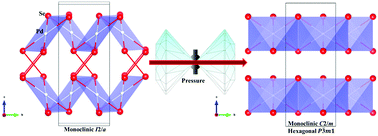A new 2D high-pressure phase of PdSe2 with high-mobility transport anisotropy for photovoltaic applications†
Abstract
Two-dimensional dichalcogenides (2D TMDCs) have emerged as a class of materials that may impact on future nanoelectronic and optoelectronic technologies. Design and discovery of new TMDC materials with reduced dimensionality is a significant and particularly interesting subject. Here, we proposed a new 2D layered structure material PdSe2 realized via high pressure by first-principles simulations. We found PdSe2 undertaking structural phase transitions under pressure, from the monoclinic phase with a space group of I2/a to two similar 2D layered structure phases with monoclinic C2/m and hexagonal P![[3 with combining macron]](https://www.rsc.org/images/entities/char_0033_0304.gif) m1 space groups at 4.5 GPa and 17.5 GPa, respectively. Interestingly, a new type of 2D monolayer material PdSe2 can be cleaved from the monoclinic C2/m bulk phase, suggested by the small exfoliation energy of 33.85 meV Å−2 (0.54 J m−2). More importantly, the new 2D PdSe2 monolayer is not only confirmed to be both dynamically and thermally stable, but also possesses a moderate band gap of about 1.10 eV and excellent visible-light optical absorption, suitable for photovoltaic applications. Furthermore, the effective masses and carrier mobility of the electrons and holes display extraordinary anisotropy along different transport directions, indicating that the monoclinic monolayer PdSe2 is a promising 2D material to facilitate effective electron/hole separation in high-performance nanoelectronic devices.
m1 space groups at 4.5 GPa and 17.5 GPa, respectively. Interestingly, a new type of 2D monolayer material PdSe2 can be cleaved from the monoclinic C2/m bulk phase, suggested by the small exfoliation energy of 33.85 meV Å−2 (0.54 J m−2). More importantly, the new 2D PdSe2 monolayer is not only confirmed to be both dynamically and thermally stable, but also possesses a moderate band gap of about 1.10 eV and excellent visible-light optical absorption, suitable for photovoltaic applications. Furthermore, the effective masses and carrier mobility of the electrons and holes display extraordinary anisotropy along different transport directions, indicating that the monoclinic monolayer PdSe2 is a promising 2D material to facilitate effective electron/hole separation in high-performance nanoelectronic devices.

- This article is part of the themed collection: 2019 Journal of Materials Chemistry C HOT Papers


 Please wait while we load your content...
Please wait while we load your content...